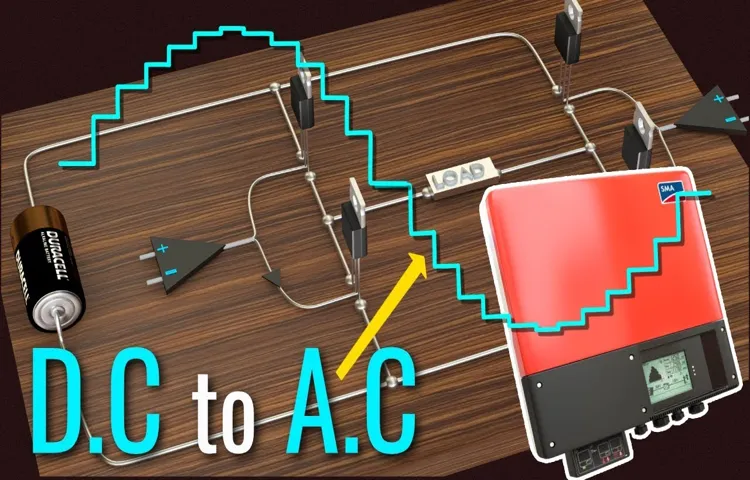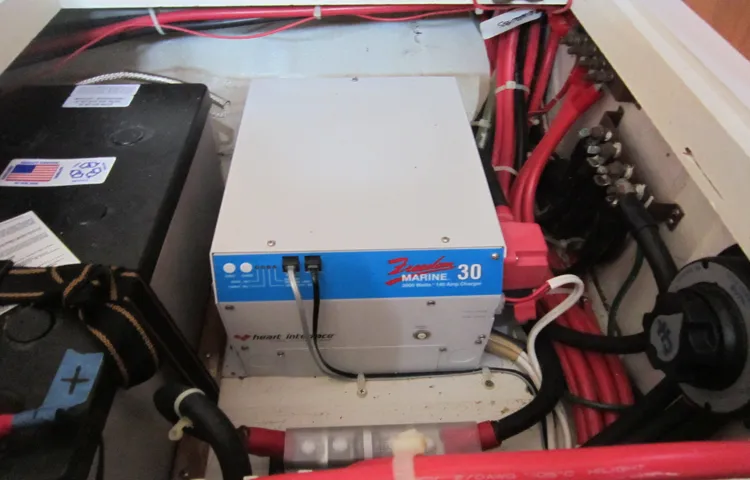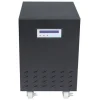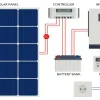If you’ve ever wondered how to power your electronics or appliances when you’re off the grid or during a power outage, a power inverter might just be the answer you’re looking for. But what exactly is a power inverter? Think of a power inverter as a translator between your battery and your devices. It takes the DC (direct current) power from your battery and converts it into AC (alternating current) power that can be used to run your appliances or charge your devices.
In other words, it allows you to use your battery to power devices that require standard household electricity. Power inverters come in a range of sizes and capacities, depending on your power needs. You can find smaller inverters that plug into your car’s cigarette lighter and are perfect for charging your phone or running small electronics.
On the other end of the spectrum, there are larger inverters that can power your entire house during an outage, providing electricity for appliances like refrigerators, air conditioners, and even power tools. Whether you’re a camping enthusiast looking to power your gadgets in the great outdoors, or a homeowner preparing for the next storm, a power inverter can be a valuable tool. It gives you the flexibility to use electricity wherever you need it, without relying on traditional power sources.
So next time you find yourself without power, just remember the power inverter – your portable electrical translator that keeps you connected.
Table of Contents
- 1 Definition and purpose of a power inverter
- 2 Different types of power inverters
- 3 Selecting the right power inverter for a boat
- 4 Installation and operation of a power inverter on a boat
- 5 Safety considerations when using a power inverter on a boat
- 6 Conclusion: Enjoying the benefits of a power inverter on a boat
- 7 FAQs
Definition and purpose of a power inverter
power inverters on boats
Different types of power inverters
If you’ve ever wondered how a power inverter works on a boat, you’re in the right place. Power inverters are essential for converting DC power from your boat’s batteries into AC power that can be used to run appliances and electronics. There are different types of power inverters, including modified sine wave inverters and pure sine wave inverters.
Modified sine wave inverters are the most common and affordable option, but they may not be suitable for sensitive electronics as they can produce a less smooth power output. On the other hand, pure sine wave inverters provide a cleaner and more stable power output, making them ideal for use with sensitive electronics. Both types of inverters work by taking the DC power from the boat’s batteries and using electronic circuits to convert it into AC power.
This AC power can then be used to run various devices on the boat, such as refrigerators, televisions, and even power tools. So, whether you’re planning a day out on the water or a longer boating trip, a power inverter is a must-have accessory to ensure that you can still enjoy the comforts of home while aboard your boat.

Modified sine wave inverters
power inverters, Modified sine wave inverters, different types of power inverters
Pure sine wave inverters
power inverters
Selecting the right power inverter for a boat
If you’re planning to power your boat’s appliances and electronics while out on the water, a power inverter is essential. But how does a power inverter work on a boat? Well, it’s quite simple actually. A power inverter takes the DC (direct current) power from your boat’s batteries and converts it into AC (alternating current) power, which is what most appliances and devices in your boat require.
This allows you to use standard household appliances and electronics on your boat, just like you would at home. It’s like having a small electrical power plant on board! But it’s important to select the right power inverter for your boat’s needs. You need to consider the power rating of the inverter, which is measured in watts, to ensure it can handle the electrical load of your appliances.
You also need to consider the type of inverter, whether it’s modified sine wave or pure sine wave. A modified sine wave inverter is more affordable, but it may not be compatible with all appliances, especially those with sensitive electronics. On the other hand, a pure sine wave inverter is more expensive, but it provides a clean and consistent power output that’s safe for all appliances.
So, if you want to enjoy the comforts and convenience of home while out on your boat, make sure you choose the right power inverter.
Calculating power needs
power inverter, boat, calculating power needs, selecting the right power inverter Have you ever wondered how you can power your electronics on your boat? Well, look no further than a power inverter. A power inverter is a device that can convert the DC power from your boat’s battery into AC power that can be used to run your appliances and electronics. But before you rush out to buy a power inverter, it’s important to calculate your power needs and select the right one for your boat.
To calculate your power needs, you’ll need to take an inventory of all the appliances and electronics you plan to use on your boat. Make a list of everything from your refrigerator and microwave to your TV and phone charger. Then, determine the wattage of each item.
You can usually find this information on the label or in the owner’s manual. Once you have the wattage for each item, add them all up to get your total power needs. This will give you an idea of how much power you’ll need your inverter to provide.
Keep in mind that it’s usually best to choose an inverter that can handle a bit more power than you think you’ll need, just to be on the safe side. Now that you have an idea of how much power you’ll need, it’s time to select the right power inverter for your boat. There are a few factors to consider when making your decision.
First, think about the size of the inverter. If you have limited space on your boat, you’ll want to choose a compact inverter that can easily fit into a small space. Next, consider the input voltage.
Most boats have a 12-volt DC system, so you’ll want to look for an inverter that can handle that voltage. Some inverters also have the ability to handle higher voltages, so if you have a boat with a 24-volt or 48-volt system, be sure to choose one that can accommodate that. Lastly, think about the surge capacity of the inverter.
Considering the boat’s electrical system
power inverter, boat, electrical system
Installation and operation of a power inverter on a boat
Installing and operating a power inverter on a boat can greatly enhance its capabilities and provide convenience while on board. But how does a power inverter work on a boat? Well, a power inverter is a device that converts the DC (direct current) power from the boat’s battery into AC (alternating current) power, which is commonly used by our household appliances and electronics. The inverter takes the 12V or 24V DC power from the battery and converts it into the 120V AC power that our devices need to function.
This allows boaters to use their regular electronics and appliances, such as laptops, TVs, and kitchen appliances, even when they are out at sea. The power inverter acts as a bridge between the boat’s battery and the devices we want to power, ensuring that we can enjoy modern conveniences while on our boat adventures. So, whether you want to charge your phone, run a blender, or watch a movie on your boat, a power inverter is the key to making it all possible.
Wiring the inverter to the boat’s battery
power inverter, boat’s battery, installation, operation
Using the inverter to power AC appliances on the boat
power inverter, AC appliances, boat, installation, operation Are you looking to power AC appliances on your boat? Well, installing a power inverter is the way to go! A power inverter is a device that converts DC power from your boat’s batteries into AC power, allowing you to run appliances like microwaves, TVs, and laptops. The installation process is relatively simple, but it’s important to follow the manufacturer’s instructions and take proper safety precautions. Once the inverter is installed, it’s just a matter of connecting your AC appliances to the inverter and turning it on.
Now you can enjoy all the comforts of home while out on the water! Just remember to keep an eye on your battery levels and turn off the inverter when not in use to conserve power. So go ahead, power up those AC appliances on your boat and make your time on the water even more enjoyable!
Monitoring the inverter’s performance
power inverter on a boat
Safety considerations when using a power inverter on a boat
If you’re planning to use a power inverter on a boat, there are a few safety considerations to keep in mind. First and foremost, it’s important to understand how a power inverter works. Essentially, it converts the 12-volt DC power from your boat’s battery into 120-volt AC power, allowing you to run appliances and electronics that require AC power.
Now, when it comes to safety, one of the main things to be aware of is the capacity of your boat’s battery. Power inverters can draw a significant amount of power, so it’s essential to ensure that your battery can handle the load. Using an inverter with a battery that is not powerful enough can result in the battery being drained quickly or even potentially damaging the battery.
In addition to ensuring you have a battery with enough capacity, it’s also important to properly install and ground the power inverter. This means following the manufacturer’s instructions and using the correct size cables and connectors. It’s crucial to choose the right location for the inverter, away from any moisture or potential sources of water, as this can lead to electrical hazards.
Another safety consideration is the use of appropriate fuses or circuit breakers. These devices protect both the inverter and your boat’s electrical system from overloading or short circuits. It’s important to choose the correct size fuse or circuit breaker based on the inverter’s power rating.
Lastly, make sure to use caution when connecting appliances or devices to the power inverter. Ensure that the devices you are powering are compatible with the inverter’s power output. It’s also wise to unplug or turn off the inverter when not in use to prevent any accidental electrical shocks.
By keeping these safety considerations in mind and following proper installation and usage guidelines, you can ensure that using a power inverter on your boat is both efficient and safe. Happy boating!
Grounding and insulation of the inverter
power inverter, boat, safety considerations, grounding, insulation In order to ensure the safety of using a power inverter on a boat, it is important to consider the grounding and insulation of the inverter. Grounding refers to the process of connecting the inverter to a grounded system, such as the boat’s metal hull or an earth ground. This helps to prevent the buildup of static electricity and reduces the risk of electrical shock.
Insulation, on the other hand, involves protecting the inverter from any potential damage or interference from other electrical components on the boat. This can be achieved by using proper insulation materials and ensuring that the inverter is installed in a location that is free from excessive heat or moisture. By taking these safety considerations into account, you can enjoy the benefits of using a power inverter on your boat without compromising the safety of yourself or others on board.
Proper ventilation and cooling
power inverter, boat, proper ventilation, cooling, safety considerations
Preventing electrical shocks
power inverter, electrical shocks, safety considerations, boat
Conclusion: Enjoying the benefits of a power inverter on a boat
In conclusion, a power inverter on a boat is like the conductor of a floating symphony. It takes the DC power from your boat’s batteries and transforms it into AC power, allowing you to plug in all your electronic devices and luxuries while sailing the open seas. Just like a clever magician, the inverter uses its secret spell of transistors and circuitry to perform its trickery, converting the energy with flawless precision.
So, the next time you’re aboard a boat and witness the wonders of electricity working its magic, remember that behind the scenes, the power inverter is the true star of the show, keeping you powered up and cruising in style.
FAQs
What is a power inverter and how does it work on a boat?
A power inverter is a device that converts DC (Direct Current) power from a boat’s batteries into AC (Alternating Current) power that can be used to operate various electrical devices. It works by using electronic circuits to change the voltage and frequency of the incoming DC power to match that of the AC power supply.
Why would you need a power inverter on a boat?
A power inverter is useful on a boat as it allows you to power AC devices or appliances that would typically require a standard household power outlet. This includes devices such as laptops, televisions, kitchen appliances, and charging ports for electronic devices.
What are the different types of power inverters that can be used on a boat?
There are primarily two types of power inverters used on boats – modified sine wave inverters and pure sine wave inverters. Modified sine wave inverters are more commonly found and are suitable for most household appliances. Pure sine wave inverters, on the other hand, provide a cleaner and more stable power output, making them suitable for sensitive electronics or appliances.
Can a power inverter drain the boat’s batteries?
Yes, a power inverter can drain the boat’s batteries if used without caution. It is important to properly size the power inverter based on the devices you plan to use and their power requirements. Additionally, monitoring the battery voltage and managing the power consumption is crucial to prevent excessive draining of the batteries.
Are power inverters safe to use on a boat?
Power inverters are generally safe to use on a boat when installed and used correctly. It is important to follow the manufacturer’s instructions for installation, ensure proper ventilation, and use appropriate circuit protection devices. It is also advisable to periodically inspect the inverter and its connections for any signs of damage or wear.
Can a power inverter work with solar panels on a boat?
Yes, a power inverter can work with solar panels on a boat. Solar panels generate DC power, which can be converted into AC power using a power inverter. This allows the boat to utilize solar energy to power AC devices or appliances.
Can a power inverter work while the boat’s engine is running?
Yes, a power inverter can work while the boat’s engine is running. When the engine is running, the boat’s alternator charges the batteries, providing the necessary DC power for the inverter to convert into AC power. This allows for a continuous power supply even when the boat’s engine is running.



